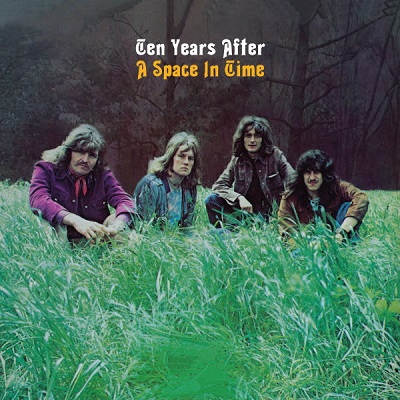Six months after the 1969 Woodstock Music & Art Festival shook the planet with a somewhat chaotic, but overall peaceful three days, a film came out about the event. In between scenes of the audience, the organizers, the crews, the volunteers, and the challenges they all faced were key takeaway performances by half the acts on the bill. The Woodstock movie, which went on to win the Best Documentary Academy Award, did more to prop up several profiles than the festival itself. Among those who got a big push up the ladder was British blues band Ten Years After. Their lively take of “I’m Going Home” turned their fortunes overnight, and they were soon in the envious position of becoming as big as Led Zeppelin. Their two studio albums in 1970 — Cricklewood Green and Watt — were steps in the right direction, but it was 1971’s A Space In Time, their first release on Columbia Records, that catapulted them to their greatest commercial success.
To celebrate its 50-plus years of existence, there are configurations with a new stereo remix by engineer Chris Kimsey (who worked on the record), the original 1971 mix, a 5.1 DTS HD-Master Audio 5.1 mix, and the 1973 Quad Mix in DTS HD-Master Audio 4.0. The surround and quad mixes are only available on a limited-edition Blu-ray Disc that’s, at press-time, sold out. For even the simplest of listening pursuits, both the updated mix and Dolby Atmos mix add a lot of space and separation to the overall ambience. Electric and acoustic guitars have been brightened up and Alvin Lee’s vocals are a little louder. Track through the album’s 10 songs, and you’ll be transported back to the salad days of rock and roll.
A Space In Time captures a much more relaxed and at-ease group of musicians than the ones who played Woodstock. “One Of These Days” and “Baby Won’t You Let Me Rock N’ Roll You” reaffirm the group’s edgier side, but the album is mostly driven by the acoustic guitar on songs like “Here We Come,” “Over The Hill,” “Hard Monkeys,” and the breakout hit, “I’d Love To Change The World.” For a group known for their electric live performances, A Space In Time likely stunned many of its longtime followers while it embraced a much bigger audience. Even so, Alvin Lee, who wrote and sang nine of the album’s songs, refused to play “I’d Love To Change The World” live because of its inclusion of both acoustic and electric guitar.
You certainly can’t escape the psychedelic gloss of “Let The Sky Fall” or the smoky informality of “Uncle Jam,” where keyboardist Chick Churchill, drummer Ric Lee and bassist Leo Lyons each plummet their musical chops alongside Alvin Lee. For no other reason, it shows why they were worthy to all be in the same band together.
Ten Years After never quite measured up to the appeal and chemistry of A Space In Time with subsequent releases, and they eventually broke up in 1974. The original unit reunited here and there in the 80s, 90s and early 00s. Alvin Lee quit for good in 2003 and passed away in 2013. Ten Years After caries on to this day, but the memory of their appearance at Woodstock, A Space In Time, and singer, guitarist and songwriter Alvin Lee have a sacred and secure place in the history of rock and roll.
~ Shawn Perry




















